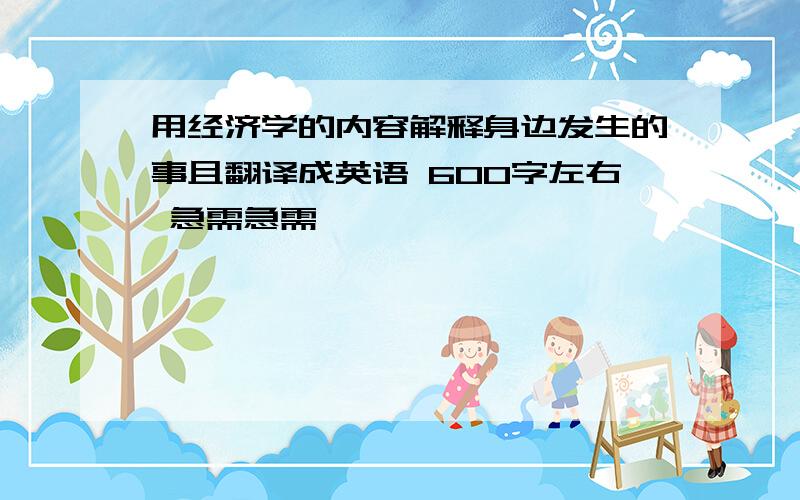用经济学的内容解释身边发生的事且翻译成英语 600字左右 急需急需
来源:学生作业帮 编辑:大师作文网作业帮 分类:英语作业 时间:2024/11/19 19:55:08
用经济学的内容解释身边发生的事且翻译成英语 600字左右 急需急需

Principle one:people are faced with trade-offs
When people form society,they face a variety of trade-offs.Typical in the "guns and butter" choice between.Cannon on behalf of military spending,civil costs on behalf of butter.Quote the words of President Eisenhower that the military share of the resources more available for civilian consumption and investment of resources will be less.In modern society,there are also many similar things.Government resources for the production of public goods more,the remaining resources for the production of private goods less; we used to consume more food,the clothes are used to spending less; student time for learning more,then less time for rest.
Principle two:the cost of something is to give up something to get it
Opportunity cost is the kind of thing to give up in order to get something.For example,a company decided to park in a nearby gold mining costs.Miners,said ticket sales because the park is almost unaffected,so the low cost of gold mining.But can be found along with the noise caused by gold mining,water and air pollution,environmental degradation,etc.,it really does not affect the park's scenic value?Although the monetary value of the cost may be small,but taking into account environmental and ecological value will be lost,so in fact may be significant opportunity costs.
Principle Three:rational people consider the marginal amount
Marginal amount "refers to a certain economic variables in the factors affecting the changes that occurred under the amount that each increase of one unit of input is the increase in production.To do with the tug of war analogy,one a total of 10 individuals,total pull Wei 300 kg now increase a person seating,the arrival of Joe Smith makes this side of the tension has increased by 25 kg,25 kg is the marginal amount added to a John Doe,John Doe's arrival added to 20 kg tension,this is the marginal amount of total to say,the marginal increase in the amount often is decreasing,but also with the tug of war as an example,assuming the power of each individual are the same 25 kg,when the small number,when everyone with a better,everyone can play 25 kilograms of force and later added a person,everyone is a bit hard time dislocation,additional people can only make the actual total increase of 24 kg of pull strength.continue to increase people say,we have more hard time dislocation ,he can only pull so that the total increase of 23 kilograms of force.with the increase in the number of each person to bring incremental (that is,the marginal amount) are on the decline,the total tension (that is,total) rate of increase more slowly,until the last one can not increase again until the number to increase if it is possible to bring the amount of negative marginal.
译文:
原理一:人们面临权衡取舍(people face trade-offs)
当人们组成社会时,他们面临各种不同的权衡取舍.典型的是在“大炮与黄油”之间的选择.大炮代表军费开支,黄油代表民用开支.引用艾森豪威尔总统的话就是,军事上所占的资源越多,可供民用消费和投资的资源就会越少.在现代社会里,同样也有很多类似的事情.政府用于生产公共品的资源越多,剩下的用于生产私人品的资源就越少;我们用来消费的食品越多,则用来消费的衣服就越少;学生用于学习的时间越多,那么用于休息的时间就越少.
原理二:某种东西的成本是为了得到它而放弃的东西( the cost of something is what you give up to get it)
机会成本(opportunitycost)是为了得到这种东西所放弃的东西.例如某公司决定在一个公园附近开采金矿的成本.开采者称由于公园的门票收入几乎不受影响,因此金矿开采的成本很低.但可以发现伴随着金矿开采带来的噪声、水和空气的污染、环境的恶化等,是否真的不会影响公园的风景价值?尽管货币价值成本可能会很小,但是考虑到环境和自然生态价值会丧失,因此机会成本事实上可能很大.
原理三:理性人考虑边际量(rational people think at margin)
边际量”是指某个经济变量在一定的影响因素下发生的变动量.它是每增加一单位投入所增加的产量.用拔河来做比喻,一方共有10个人,总拉力为300公斤.现在增加一个人张三,张三的到来使得这一方的拉力增加了25公斤,这个25公斤就是边际量.又增加一个李四,李四的到来又增加20公斤拉力,这个也是边际量.总的说来,边际量的增加往往是递减的,还用拔河做例子.假设每一个人的力量都是一样的25公斤,当人数少的时候,大家配合的比较好,每一个人都能发挥25公斤的力量.后来增加了一个人,大家一起使劲的时间就有点错位,新增加的人实际只能让总拉力增加24公斤的力量.继续增加人的话,大家使劲的时间就有更多的错位,他只能让总拉力增加23公斤的力量.随着人数的增加,每个人带来的增量(就是边际量)都在减少,总拉力(就是总量)增加的速度越来越慢,直到最后再来一个人也不能增加为止,如果再增加人数的,就有可能带来负的边际量了.
When people form society,they face a variety of trade-offs.Typical in the "guns and butter" choice between.Cannon on behalf of military spending,civil costs on behalf of butter.Quote the words of President Eisenhower that the military share of the resources more available for civilian consumption and investment of resources will be less.In modern society,there are also many similar things.Government resources for the production of public goods more,the remaining resources for the production of private goods less; we used to consume more food,the clothes are used to spending less; student time for learning more,then less time for rest.
Principle two:the cost of something is to give up something to get it
Opportunity cost is the kind of thing to give up in order to get something.For example,a company decided to park in a nearby gold mining costs.Miners,said ticket sales because the park is almost unaffected,so the low cost of gold mining.But can be found along with the noise caused by gold mining,water and air pollution,environmental degradation,etc.,it really does not affect the park's scenic value?Although the monetary value of the cost may be small,but taking into account environmental and ecological value will be lost,so in fact may be significant opportunity costs.
Principle Three:rational people consider the marginal amount
Marginal amount "refers to a certain economic variables in the factors affecting the changes that occurred under the amount that each increase of one unit of input is the increase in production.To do with the tug of war analogy,one a total of 10 individuals,total pull Wei 300 kg now increase a person seating,the arrival of Joe Smith makes this side of the tension has increased by 25 kg,25 kg is the marginal amount added to a John Doe,John Doe's arrival added to 20 kg tension,this is the marginal amount of total to say,the marginal increase in the amount often is decreasing,but also with the tug of war as an example,assuming the power of each individual are the same 25 kg,when the small number,when everyone with a better,everyone can play 25 kilograms of force and later added a person,everyone is a bit hard time dislocation,additional people can only make the actual total increase of 24 kg of pull strength.continue to increase people say,we have more hard time dislocation ,he can only pull so that the total increase of 23 kilograms of force.with the increase in the number of each person to bring incremental (that is,the marginal amount) are on the decline,the total tension (that is,total) rate of increase more slowly,until the last one can not increase again until the number to increase if it is possible to bring the amount of negative marginal.
译文:
原理一:人们面临权衡取舍(people face trade-offs)
当人们组成社会时,他们面临各种不同的权衡取舍.典型的是在“大炮与黄油”之间的选择.大炮代表军费开支,黄油代表民用开支.引用艾森豪威尔总统的话就是,军事上所占的资源越多,可供民用消费和投资的资源就会越少.在现代社会里,同样也有很多类似的事情.政府用于生产公共品的资源越多,剩下的用于生产私人品的资源就越少;我们用来消费的食品越多,则用来消费的衣服就越少;学生用于学习的时间越多,那么用于休息的时间就越少.
原理二:某种东西的成本是为了得到它而放弃的东西( the cost of something is what you give up to get it)
机会成本(opportunitycost)是为了得到这种东西所放弃的东西.例如某公司决定在一个公园附近开采金矿的成本.开采者称由于公园的门票收入几乎不受影响,因此金矿开采的成本很低.但可以发现伴随着金矿开采带来的噪声、水和空气的污染、环境的恶化等,是否真的不会影响公园的风景价值?尽管货币价值成本可能会很小,但是考虑到环境和自然生态价值会丧失,因此机会成本事实上可能很大.
原理三:理性人考虑边际量(rational people think at margin)
边际量”是指某个经济变量在一定的影响因素下发生的变动量.它是每增加一单位投入所增加的产量.用拔河来做比喻,一方共有10个人,总拉力为300公斤.现在增加一个人张三,张三的到来使得这一方的拉力增加了25公斤,这个25公斤就是边际量.又增加一个李四,李四的到来又增加20公斤拉力,这个也是边际量.总的说来,边际量的增加往往是递减的,还用拔河做例子.假设每一个人的力量都是一样的25公斤,当人数少的时候,大家配合的比较好,每一个人都能发挥25公斤的力量.后来增加了一个人,大家一起使劲的时间就有点错位,新增加的人实际只能让总拉力增加24公斤的力量.继续增加人的话,大家使劲的时间就有更多的错位,他只能让总拉力增加23公斤的力量.随着人数的增加,每个人带来的增量(就是边际量)都在减少,总拉力(就是总量)增加的速度越来越慢,直到最后再来一个人也不能增加为止,如果再增加人数的,就有可能带来负的边际量了.